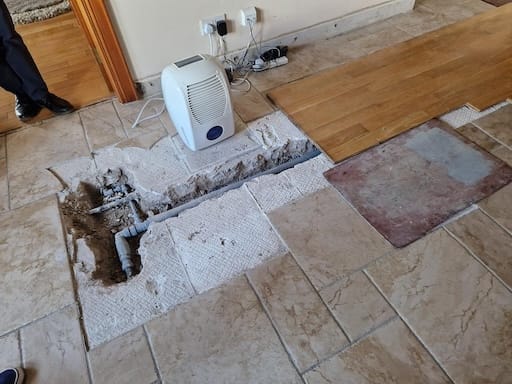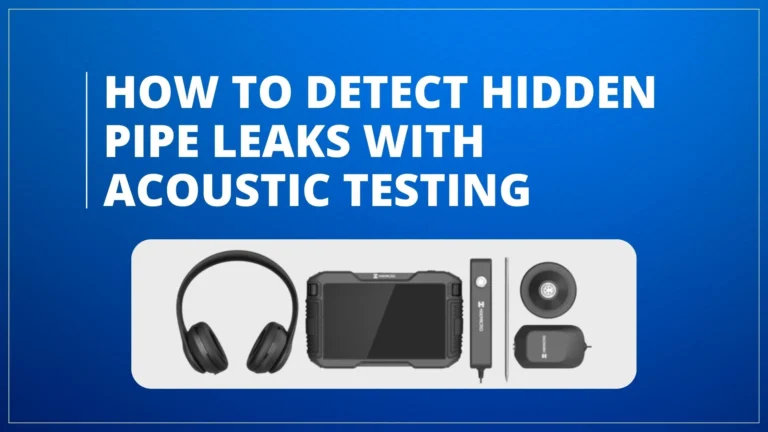Water leaks in copper pipes buried in concrete floor slabs are a common issue in domestic properties across the UK. These leaks can cause significant structural damage, increase water bills, and lead to costly repairs if not detected early.
One of the most effective and non-invasive methods to locate these leaks is through acoustic testing. This technique has gained popularity in recent years due to its accuracy and minimal disruption to the property.
In this post, we’ll discuss acoustic testing as a method for leak detection in copper pipes, detailing what it involves, the equipment required, the best scenarios for its use, and its advantages and disadvantages.
What is Acoustic Testing for Leak Detection?
Acoustic testing, also known as acoustic leak detection, is a technique used to identify leaks in pipes by detecting the sound produced by escaping water. As water leaks from a pressurised pipe, it generates noise due to the friction between the water and the pipe, as well as the pressure loss at the leak site. These sounds are usually inaudible to the human ear, but acoustic testing equipment amplifies and isolates them, allowing plumbers to pinpoint the exact location of the leak without needing to break open floors or walls.
The sounds produced by a leak vary depending on factors such as the size of the leak, the material of the pipe, and the surrounding environment. Copper pipes produce a distinct noise when leaking due to the rigid nature of the metal, which transmits sound more effectively than plastic or PVC pipes.
Equipment Needed for Acoustic Testing

To conduct acoustic leak detection, a plumber or technician requires specialised equipment designed to capture and amplify the sounds made by the leak. The following tools are essential for successful acoustic testing:
1. Acoustic Leak Detector
This device is the core component of the acoustic testing process. It consists of a sensitive microphone that detects the sounds produced by water escaping from a pipe. The microphone is typically attached to a handheld unit with headphones or a display screen, allowing the plumber to listen for the telltale hissing, dripping, or rushing sounds of a leak.
2. Ground Microphone
A ground microphone is a sensor that is specifically designed to detect leaks beneath the surface, such as those in concrete floor slabs. It picks up vibrations and sound waves travelling through solid surfaces and is especially useful for pinpointing leaks deep within floors or walls.
3. Amplifier and Filter System
Once the microphone captures the sounds of the leak, an amplifier boosts the signal, making it easier to hear or analyse. Filters are also applied to remove background noise, such as footsteps or ambient sounds, ensuring that the only noise picked up is related to the leak.
4. Headphones
Professional-grade headphones are used by the plumber or technician to listen for the leak. These headphones are designed to filter out external noise, allowing the user to focus solely on the amplified sounds detected by the acoustic equipment.
5. Hydrophones
In some cases, hydrophones—sensors specifically designed to be used in water—are employed. These are inserted into the pipe system and detect changes in sound from within, making them particularly effective for finding leaks in pipes submerged in water or buried deep under floors.
How Does Acoustic Testing Work?
The acoustic leak detection process typically follows several steps:
- Pressurising the System: First, the plumber will ensure that the water system is pressurised, which increases the likelihood of a leak producing a noticeable sound. If the system is not pressurised, the plumber may use air or water pressure to artificially create this condition.
- Initial Survey: The plumber performs a general survey of the property using the ground microphone, listening for any signs of a leak. This step helps to identify the general area where the leak might be located.
- Sound Isolation: Once the general area of the leak has been detected, the plumber will move the ground microphone or acoustic detector around to pinpoint the exact location. This step may involve adjusting the settings on the amplifier to filter out unnecessary noise.
- Cross-Checking: The plumber may cross-check the results by using other sensors, such as hydrophones or additional acoustic detectors, to ensure the accuracy of the reading.
- Marking the Leak: Once the leak has been identified, the plumber marks the location for further investigation or repair. The marked spot is often very precise, minimising the need for unnecessary drilling or excavation.
When is Acoustic Testing Best Used?

1. Concrete Slabs and Sub-Surface Leaks
Acoustic testing is particularly effective for leaks located under concrete slabs, making it a preferred method in homes where the plumbing is embedded in the flooring. Copper pipes, often used in older UK properties, are known to corrode over time, leading to small pinhole leaks that can be difficult to detect without specialised equipment.
2. Early Detection of Small Leaks
Acoustic testing is sensitive enough to detect even small leaks before they become a major issue. This is important for preventing water damage and avoiding the need for more extensive repairs later.
3. Minimally Invasive Diagnosis
When homeowners want to avoid the disruption of breaking through floors or walls to locate a leak, acoustic testing provides a non-invasive alternative. This makes it particularly suitable for homes with expensive or difficult-to-repair flooring, such as tiled or hardwood floors.
Did you know…
Acoustic testing has a 90-95% success rate in detecting leaks in copper pipes within concrete slabs. This high accuracy rate, combined with its non-invasive nature, has made it the preferred method for leak detection in homes across the UK.
Advantages of Acoustic Testing
1. Non-Invasive
The most significant advantage of acoustic leak detection is its non-invasive nature. Unlike traditional methods, which often require breaking open concrete slabs or drilling into walls to locate leaks, acoustic testing allows plumbers to detect the problem without causing any structural damage. This not only saves time but also reduces repair costs and disruption for homeowners.
2. Accuracy
Acoustic testing is highly accurate, particularly when combined with modern amplifiers and filters that can isolate leak sounds from background noise. This precision allows plumbers to pinpoint the exact location of a leak, reducing the area that needs to be repaired.
3. Cost-Effective
By avoiding unnecessary excavation and repairs, acoustic testing can be a more cost-effective option in the long run. While the initial cost of hiring a plumber with acoustic equipment may be higher, the savings on labour and materials make it worthwhile.
4. Speed
The acoustic testing process is quick compared to traditional methods of leak detection. In many cases, plumbers can locate the source of a leak within an hour or two, depending on the complexity of the pipe system and the nature of the leak.
5. Effective for Multiple Pipe Types
While copper pipes are particularly suited to acoustic detection due to their sound-conducting properties, acoustic testing can also be used on a variety of other materials, including PVC, galvanised steel, and plastic.
Disadvantages of Acoustic Testing
1. High Initial Cost
The equipment needed for acoustic leak detection is specialised and often expensive, which means that not all plumbers have access to it. As a result, the initial cost of hiring a plumber who offers acoustic testing can be higher than for traditional methods.
2. Dependent on Environmental Conditions
Acoustic leak detection is highly dependent on the surrounding environment. Background noise, vibrations, and the thickness of the concrete slab can all affect the ability of the equipment to detect the sounds of a leak. In noisy environments or in cases where the leak is located very deep within a slab, acoustic detection may not always be reliable.

3. Requires Expertise
Using acoustic equipment effectively requires a high level of skill and experience. Plumbers need to be able to interpret the sounds they hear correctly, which can take time and practice. As such, it is important to hire a plumber who is well-versed in this technique.
4. Less Effective on Larger Leaks
While acoustic detection is excellent for pinpointing small leaks, larger leaks may produce more widespread sounds that are harder to isolate. In these cases, the method may not be as effective as other options, such as thermal imaging or tracer gas detection.
| Advantages | Disadvantages |
|---|---|
| Non-invasive | High initial cost |
| Accurate | Dependent on environmental conditions |
| Cost-effective in the long run | Requires expertise to use effectively |
| Quick diagnosis | Less effective on larger leaks |
| Suitable for multiple pipe types |
Comparison with Other Leak Detection Methods
| Method | Type of Leak | Invasiveness | Cost | Accuracy |
|---|---|---|---|---|
| Acoustic Testing | Hot/Cold Water | Non-invasive | Moderate | High |
| Thermal Imaging | Hot Water Only | Non-invasive | High | Moderate |
| Tracer Gas Detection | Hot/Cold Water | Semi-invasive | High | Very High |
| Electromagnetic Detection | Hot/Cold Water | Non-invasive | Very High | Moderate |
1. Thermal Imaging
Thermal imaging uses infrared cameras to detect changes in temperature caused by leaking hot water. While effective for locating hot water leaks, this method is less useful for detecting cold water leaks. Acoustic testing, by contrast, works for both hot and cold-water systems.
2. Tracer Gas Detection
In tracer gas detection, a non-toxic gas is introduced into the pipe system, and sensors detect where the gas escapes, indicating the presence of a leak. This method is extremely accurate but can be more expensive and invasive than acoustic testing. It is typically reserved for situations where acoustic testing or thermal imaging has failed to locate the leak.
3. Electromagnetic Detection
Electromagnetic methods involve using electromagnetic fields to detect changes in the flow of water or gas within a pipe system. This is a more specialised technique and is primarily used in larger industrial applications rather than in domestic properties.
Conclusion
Acoustic leak detection is one of the most effective and non-invasive methods for locating leaks in copper pipes buried in concrete floor slabs. With its high accuracy and minimal disruption to the property, it offers a clear advantage over more invasive traditional methods. While the initial cost of hiring a plumber equipped with acoustic testing tools may be higher, the long-term savings in labour, materials, and repair costs often make it the most cost-effective option in the long run.
That said, like any method, acoustic testing has its limitations. It can be affected by environmental noise and may not always be the best choice for larger or more severe leaks. However, in most domestic situations, particularly in the UK where concrete floor slabs are common, it remains a preferred solution for plumbers and homeowners alike.
By combining acoustic testing with other modern leak detection methods such as thermal imaging or tracer gas detection, plumbers can offer a comprehensive and efficient solution to one of the most challenging problems in domestic plumbing: finding and fixing leaks without causing unnecessary damage to the property.



